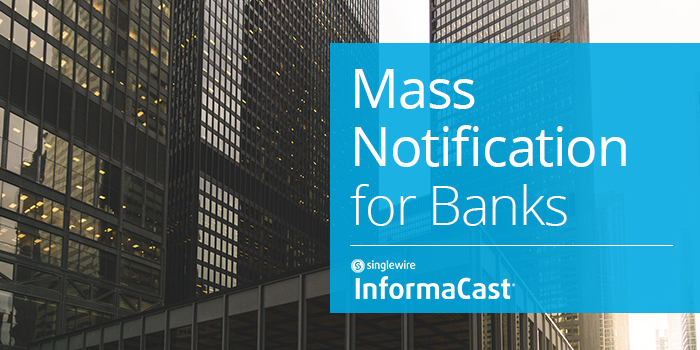Mass Notification for Banks
Like most organizations, banks and other financial institutions rely on strong communication to function. Without the right tools in place, operations can be disrupted, and people can be needlessly put into dangerous situations. Mass notification solutions can help banks connect with remote branches to alert them about potential risks, monitor ongoing incidents, and collaborate on solutions to resolve issues. In this blog post, we’ll outline how banks can leverage mass notification for safety and everyday uses to protect their people and improve processes and procedures.
Connected Communications
Mass notification systems can deploy alerts in a variety of formats to a wide range of devices to share critical information with the right people. IP desk phones, desktop computers, panic buttons, and other Internet of Things devices can all be used to silently trigger alerts that reach other desk phones and computers, mobile devices, digital signage, and more as text and audio messages. Simple and discreet notification methods make it easy for employees to ask for assistance during emergency events. These notifications can connect remote branches with headquarters and vice versa to help make everyone aware of ongoing situations.
Banks can also connect mass notification systems to collaboration tools to manage situations as they unfold. Following the distribution of a mass notification, select team members can be automatically invited to join a virtual Microsoft Teams or Webex space to quickly gather key stakeholders who can address the situation taking place. Similar functionality can also be achieved by inviting people to join a conference call. The goal should be to provide assistance as quickly as possible and that starts with getting the right people on the same page about what’s happening.
How Banks Are Using Mass Notification
Mass notification can be used for any kind of event banks think might disrupt normal operations. This could range from robberies to severe weather and anything in between. The customization available with mass notification systems means banks can build templates to prepare for anything. Here are two specific examples of how banks are using mass notification to help minimize inefficiencies and provide additional security.
A bank in Wisconsin has a window of time in which all of its branches need to request cash. If the branch misses this time window, the bank needs to send out a special armored car delivery. This happens at between five and 40 branches a day and can be an expensive problem. Using mass notification, the bank can automatically notify multiple people at each of the delinquent branches, letting them know they need to get their cash request in before the window closes. This reduces the amount of time necessary to track down these delinquent branches and avoids having to send out costly armored car deliveries.
Another banking organization in the Midwest experienced a robbery at one of its branches. While people outside of the branch knew what was happening, no one inside of the building knew whether or not help was on the way. To help solve this issue in the event of future incidents, the bank has configured an innocuous overhead page to go out within a branch in the event of a robbery using a mass notification system. This will signal to people within the building that help is on its way without endangering employees.
InformaCast mass notification from Singlewire Software can help banks manage announcements to their branches and receive alerts when an emergency event occurs. With mobile and on-premises alerting methods, InformaCast offers the most complete reach to ensure everyone receives a message during a crisis. The more people that become aware of a situation the quicker they can respond, to deliver assistance as fast as possible to protect people and assets, and maintain business continuity.
Visit our Business page for more details.
